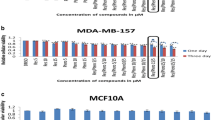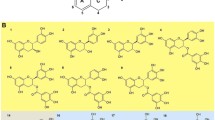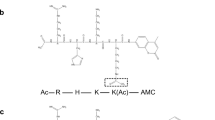Abstract
Sirtuins (SIRTs) overexpression serves as a potential therapeutic target for TNBC because it is associated with bioactivities of cancer stem cells (CSCs), resistance to chemotherapy, and metastasis. Irrespective of the availability of synthetic SIRT inhibitors, new SIRT inhibitors with enhanced potency and lesser side effects serve as current unmet needs. Therefore, bioactive dietary compounds; kaempferol (KMP) and apigenin (API) were investigated for their anti-SIRTs potential. We observed KMP and API inhibits cellular proliferation by DNA damage and S-phase cell cycle arrest in TNBC Cells. They also suppress stemness properties in TNBCs as observed in experiments of mammosphere formation and clonogenic potential. Our mechanistic approach indicated that KMP and API inhibited SIRT3 and SIRT6 proteins, as evidenced by our in silico and in vitro experiment. Collectively, our studies suggest that KMP and API are promising candidates to be further developed as sirtuin modulators against TNBCs.
Graphical abstract












Similar content being viewed by others
References
Dai X, Xiang L, Li T, Bai Z (2016) Cancer hallmarks, biomarkers and breast cancer molecular subtypes. J Cancer 7:1281–1294. https://doi.org/10.7150/jca.13141
Foulkes WD, Smith IE, Reis-Filho JS (2010) Triple-negative breast cancer. N Engl J Med 363:1938–1948. https://doi.org/10.1056/NEJMra1001389
Sharma P (2018) Update on the treatment of early-stage triple-negative breast cancer. Curr Treat Options Oncol 19:22. https://doi.org/10.1007/s11864-018-0539-8
Kim C, Gao R, Sei E et al (2018) Chemoresistance evolution in triple-negative breast cancer delineated by single-cell sequencing. Cell 173:879–893. https://doi.org/10.1016/j.cell.2018.03.041
Alhazzazi TY, Kamarajan P, Verdin E, Kapila YL (2013) Sirtuin-3 (SIRT3) and the hallmarks of cancer. Genes Cancer 4:164–171. https://doi.org/10.1177/1947601913486351
Ioris RM, Galié M, Ramadori G et al (2017) SIRT6 suppresses cancer stem-like capacity in tumors with PI3K activation independently of its deacetylase activity. Cell Rep 18:1858–1868. https://doi.org/10.1016/j.celrep.2017.01.065
Bosch-Presegué L, Vaquero A (2011) The dual role of sirtuins in cancer. Genes Cancer 2:648–662. https://doi.org/10.1177/1947601911417862
Khongkow M, Olmos Y, Gong C et al (2013) SIRT6 modulates paclitaxel and epirubicin resistance and survival in breast cancer. Carcinogenesis 34:1476–1486. https://doi.org/10.1093/carcin/bgt098
Ganai SA, Farooq Z, Banday S, Altaf M (2018) In silico approaches for investigating the binding propensity of apigenin and luteolin against class I HDAC isoforms. Future Med Chem 10:1925–1945. https://doi.org/10.4155/fmc-2018-0020
Tseng T-H, Chien M-H, Lin W-L et al (2017) Inhibition of MDA-MB-231 breast cancer cell proliferation and tumor growth by apigenin through induction of G2/M arrest and histone H3 acetylation-mediated p21(WAF1/CIP1) expression. Environ Toxicol 32:434–444. https://doi.org/10.1002/tox.22247
Marfe G, Tafani M, Indelicato M et al (2009) Kaempferol induces apoptosis in two different cell lines via Akt inactivation, Bax and SIRT3 activation, and mitochondrial dysfunction. J Cell Biochem 106:643–650. https://doi.org/10.1002/jcb.22044
Ashraf R, Hamidullah HM et al (2017) Coumarin-chalcone hybrid instigates DNA damage by minor groove binding and stabilizes p53 through post translational modifications. Sci Rep. https://doi.org/10.1038/srep45287
Meeran SM, Ahmed A, Tollefsbol TO (2010) Epigenetic targets of bioactive dietary components for cancer prevention and therapy. Clin Epigenet 1:101–116
Sinha S, Sharma S, Vora J et al (2018) Mucuna pruriens (L.) DC chemo sensitize human breast cancer cells via downregulation of prolactin-mediated JAK2/STAT5A signaling. J Ethnopharmacol 217:23–35. https://doi.org/10.1016/j.jep.2018.02.006
Shukla S, Sinha S, Khan S et al (2016) Cucurbitacin B inhibits the stemness and metastatic abilities of NSCLC via downregulation of canonical Wnt/β-catenin signaling axis. Sci Rep. https://doi.org/10.1038/srep21860
Szklarczyk D, Santos A, von Mering C et al (2016) STITCH 5: augmenting protein-chemical interaction networks with tissue and affinity data. Nucl Acids Res 44:D380–D384. https://doi.org/10.1093/nar/gkv1277
Wang X, Shen Y, Wang S et al (2017) PharmMapper 2017 update: a web server for potential drug target identification with a comprehensive target pharmacophore database. Nucl Acids Res 45:W356–W360. https://doi.org/10.1093/nar/gkx374
Davies M, Nowotka M, Papadatos G et al (2015) ChEMBL web services: streamlining access to drug discovery data and utilities. Nucl Acids Res 43:W612–W620. https://doi.org/10.1093/nar/gkv352
Sinha S, Patel S, Athar M et al (2019) Structure-based identification of novel sirtuin inhibitors against triple negative breast cancer: an in silico and in vitro study. Int J Biol Macromol 140:454–468. https://doi.org/10.1016/j.ijbiomac.2019.08.061
Piñero J, Bravo Á, Queralt-Rosinach N et al (2017) DisGeNET: a comprehensive platform integrating information on human disease-associated genes and variants. Nucl Acids Res 45:D833–D839. https://doi.org/10.1093/nar/gkw943
Safran M, Solomon I, Shmueli O et al (2002) GeneCardsTM 2002: towards a complete, object-oriented, human gene compendium. Bioinformatics 18:1542–1543. https://doi.org/10.1093/BIOINFORMATICS/18.11.1542
Shannon P, Markiel A, Ozier O et al (2003) Cytoscape: a software environment for integrated models of biomolecular interaction networks. Genome Res 13:2498–2504. https://doi.org/10.1101/gr.1239303
Szklarczyk D, Gable AL, Lyon D et al (2019) STRING v11: protein-protein association networks with increased coverage, supporting functional discovery in genome-wide experimental datasets. Nucl Acids Res 47:D607–D613. https://doi.org/10.1093/nar/gky1131
Mi H, Ebert D, Muruganujan A et al (2021) PANTHER version 16: a revised family classification, tree-based classification tool, enhancer regions and extensive API. Nucl Acids Res 49:D394–D403. https://doi.org/10.1093/NAR/GKAA1106
Parmar P, Rao P, Sharma A et al (2021) Meticulous assessment of natural compounds from NPASS database for identifying analogue of GRL0617, the only known inhibitor for SARS-CoV2 papain-like protease (PLpro) using rigorous computational workflow. Mol Divers. https://doi.org/10.1007/s11030-021-10233-3
Genheden S, Ryde U (2015) The MM/PBSA and MM/GBSA methods to estimate ligand-binding affinities. Exp Opin Drug Discov 10:449–461
Schafer KA (1998) The cell cycle: a review. Vet Pathol 35:461–478. https://doi.org/10.1177/030098589803500601
Golias C, Charalabopoulos A, Charalabopoulos K (2004) Cell proliferation and cell cycle control: a mini review. Int J Clin Pract 58:1134–1141. https://doi.org/10.1111/j.1742-1241.2004.00284.x
Madunić J, Madunić IV, Gajski G et al (2018) Apigenin: a dietary flavonoid with diverse anticancer properties. Cancer Lett 413:11–22. https://doi.org/10.1016/j.canlet.2017.10.041
Sancho P, Barneda D, Heeschen C (2016) Hallmarks of cancer stem cell metabolism. Br J Cancer 114:1305–1312. https://doi.org/10.1038/bjc.2016.152
Ajona D, Ortiz-Espinosa S, Pio R, Lecanda F (2019) Complement in metastasis: a comp in the camp. Front Immunol 10:669. https://doi.org/10.3389/fimmu.2019.00669
Tian J, al RaffaDai FM et al (2018) Dasatinib sensitises triple negative breast cancer cells to chemotherapy by targeting breast cancer stem cells. Br J Cancer. https://doi.org/10.1038/s41416-018-0287-3
Han L, Shi S, Gong T et al (2013) Cancer stem cells: therapeutic implications and perspectives in cancer therapy. Acta Pharm Sin B 3:65–75. https://doi.org/10.1016/j.apsb.2013.02.006
Yan D, Lian D, Heng-wen C (2019) Network pharmacology-based prediction and verification of the targets and mechanism for Panax Notoginseng Saponins against coronary heart disease. Evidence-based complementary and alternative medicine: eCAM.https://doi.org/10.1155/2019/6503752
Carafa V, Altucci L, Nebbioso A (2019) Dual tumor suppressor and tumor promoter action of sirtuins in determining malignant phenotype. Front Pharmacol 10:38. https://doi.org/10.3389/fphar.2019.00038
Yuan H, Su L, Chen WY (2013) The emerging and diverse roles of sirtuins in cancer: a clinical perspective. Onco Targets Ther 6:1399–1416. https://doi.org/10.2147/OTT.S37750
Angeliki C, Leonard G (2015) The multifaceted functions of sirtuins in cancer. Nat Rev Cancer 15:608–624. https://doi.org/10.1038/NRC3985
Acknowledgements
We acknowledge our host institute, B.V. Patel Pharmaceutical Education Research and Development (PERD) Centre, to provide us with the facilities to work. Author A. S. express gratitude to the Department of Science & Technology (DST), Ministry of Science and Technology, Government of India for INSPIRE fellowship (Grant no. IF190211).
Funding
This research did not receive any specific grant from funding agencies in the public, commercial, or not-for-profit sectors.
Author information
Authors and Affiliations
Contributions
AS contributed to conceptualization, data curation, methodology, writing—original draft; SS contributed to conceptualization, methodology, writing—review and editing; HK contributed to methodology; NS contributed to conceptualization, supervision, writing—review and editing.
Corresponding author
Ethics declarations
Conflict of interest
No potential conflict of interest was reported by the authors.
Additional information
Publisher's Note
Springer Nature remains neutral with regard to jurisdictional claims in published maps and institutional affiliations.
Rights and permissions
About this article
Cite this article
Sharma, A., Sinha, S., Keswani, H. et al. Kaempferol and Apigenin suppresses the stemness properties of TNBC cells by modulating Sirtuins. Mol Divers 26, 3225–3240 (2022). https://doi.org/10.1007/s11030-022-10384-x
Received:
Accepted:
Published:
Issue Date:
DOI: https://doi.org/10.1007/s11030-022-10384-x




